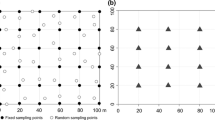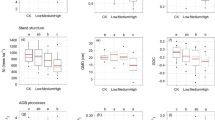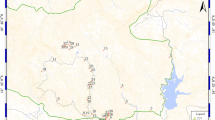Abstract
Forest disturbance and recovery are critical ecosystem processes, but the temporal patterns of disturbance have not been studied in subtropical China. Using a tree-ring analysis approach, we studied post-logging above-ground (ABG) biomass recovery dynamics over a 26-year period in four plots with different degrees of logging disturbance. Before logging, the ABG biomass ranged from 291 to 309 t ha−1. Soon after logging, the plots in primary forest, secondary forest, mixed forest and single-species forest had lost 33, 91, 90 and 100% of their initial ABG biomass, respectively. Twenty-six years after logging, the plots had regained 147, 62, 80 and 92% of their original ABG biomass, respectively. Over the 26 years following logging, the mean CAI (Current annual increment) were 10.1, 5.5, 6.4 and 10.8 t ha−1 a−1 and the average MAI (Mean annual increment) 8.7, 2.5, 5.6 and 7.8 t ha−1 a−1 for the four forest types, respectively. The results indicate that subtropical forests subjected to moderate logging or disturbances do not require intensive management and single-species plantings can rapidly restore the above-ground biomass to levels prior to heavy logging.






Similar content being viewed by others
References
Brienen RJW, Zuidema PA (2006) The use of tree rings in tropical forest management: projecting timber yields of four Bolivian tree species. For Ecol Manage 226:256–267
Brown S, Lugo AE (1990) Tropical secondary forests. J Trop Ecol 6:1–32
Canadell JG, Raupach MR (2008) Managing forests for climate change mitigation. Science 320:1456–1457
De Ridder M, Van den Bulcke J, Van Acker J, Beeckman H (2013) Tree-ring analysis of an African long-lived pioneer species as a tool for sustainable forest management. For Ecol Manage 304:417–426
Evelyne T, Ariane B, David P, Darren A (2014) Recovery rate of harvest residues for bioenergy in boreal and temperate forests: a review. Wiley Interdiscip Rev Energy Environ 3:429–451
Fang J, Chen A, Peng C, Zhao S, Ci L (2001) Changes in forest biomass carbon storage in China between 1949 and 1998. Science 292:2320–2322
Feng ZW, Wang XK, Wu G (1999) Biomass and productivity of forest ecosystems in China. Science Press, Beijing, pp 101–187
Hanberry BB, Jonesfarrand DT, Kabrick JM (2014) Historical open forest ecosystems in the Missouri Ozarks: reconstruction and restoration targets. Ecol Restor 32:407–416
Hanberry BB, He HS, Shifley SR (2016) Loss of aboveground forest biomass and landscape biomass variability in Missouri, US. Ecol Complex 25:11–17
Houghton RA (1999) The annual net flux of carbon to the atmosphere from changes in land use 1850–1990. Tellus Ser B Chem Phys Meteorol 51:298–313
HyvöNen R, Kaarakka L, Leppälammi-Kujansuu J, Olsson BA, Palviainen M, Vegerfors-Persson B, Helmisaari HS (2016) Effects of stump harvesting on soil C and N stocks and vegetation 8–13 years after clear-cutting. For Ecol Manage 371:23–32
Karlsson M, Nilsson U, Örlander G (2002) Natural regeneration in clear-cuts: effects of scarification, slash removal and clear-cut age. Scand J For Res 17:131–138
Kira T (1991) Forest ecosystems of east and Southeast Asia in a global perspective. Ecol Res 6:185–200
Li W (2004) Degradation and restoration of forest ecosystems in China. For Ecol Manage 201:33–41
Lieberman M, Lieberman D (1985) Simulation of growth curves from periodic increment data. Ecology 66:632–635
Lin D, Lai J, Yang B, Song P, Li N, Ren H, Ma K (2015) Forest biomass recovery after different anthropogenic disturbances: relative importance of changes in stand structure and wood density. Eur J Forest Res 134:769–780
Liu X, Xiao Z, Ma J (2002) Scientific survey and study on the forest ecosystem in Jiangxi Nature Reserve. China Forestry Publishing House, Beijing, pp 55–335
López L, Villalba R, Bravo F (2013) Cumulative diameter growth and biological rotation age for seven tree species in the Cerrado biogeographical province of Bolivia. For Ecol Manage 292:49–55
Masek JG, Huang C, Wolfe R, Cohen W, Hall F, Kutler J, Nelson P (2008) North American forest disturbance mapped from a decadal Landsat record. Remote Sens Environ 112:2914–2926
Mazzei L, Sist P, Ruschel A, Putz FE, Marco P, Pena W, Ribeiro Ferreira JE (2010) Above-ground biomass dynamics after reduced-impact logging in the Eastern Amazon. For Ecol Manage 259:367–373
Miller DA, Wigley TB, Miller KV (2009) Managed forests and conservation of terrestrial biodiversity in the southern United States. J For 107:197–203
Oliver CD, Larson BC (1990) Forest stand dynamics. McGraw-Hill, New York, pp 34–35
Ouyang S, Xiang W, Wang X, Zeng Y, Lei P (2016) Significant effects of biodiversity on forest biomass during the succession of subtropical forest in south China. For Ecol Manage 372:291–302
Pacala SW, Hurtt GC, Baker D, Peylin P, Houghton RA, Birdsey RA, Heath L, Sundquist ET, Stallard RF, Ciais P, Moorcroft P, Caspersen JP, Shevliakova E, Moore B, Kohlmaier G, Holland E, Gloor M, Harmon ME, Fan SM, Sarmiento JL, Goodale CL, Schimel D, Field CB (2001) Consistent land- and atmosphere-based U.S. carbon sink estimates. Science 292:2316–2320
Pan Y, Birdsey RA, Fang J, Houghton R, Kauppi PE, Kurz WA, Phillips OL, Shvidenko A, Lewis SL, Canadell JG, Ciais P, Jackson RB, Pacala SW, McGuire AD, Piao S, Rautiainen A, Sitch S, Hayes D (2011) A large and persistent carbon sink in the world’s forests. Science 333:988–993
Piao S, Fang J, Ciais P, Peylin P, Huang Y, Sitch S, Wang T (2009) The carbon balance of terrestrial ecosystems in China. Nature 458:1009
Ren Y, Chen S, Wei X, Xi W, Luo Y, Song X, Zuo S, Yang Y (2016) Disentangling the factors that contribute to variation in forest biomass increments in the mid-subtropical forests of China. J For Res 27(8):919–930
Saarinen VM (2006) The effects of slash and stump removal on productivity and quality of forest regeneration operations—preliminary results. Biomass Bioenerg 30:349–356
Saatchi SS, Houghton RA, Alvalá RCDS, Soares JV, Yu Y (2007) Distribution of aboveground live biomass in the Amazon basin. Glob Change Biol 13:816–837
Saksa T (2013) Regeneration after stump harvesting in southern Finland. For Ecol Manage 290:79–82
Toshio T, Li C, Goro I, Li W, Shigenobu T, Kyozo C, Shigeo K (2001) A study on the evergreen broad-leaved forest in the Jiulian Mountain of Jiangxi province. Resour Sci 23:15–35 (in Chinese)
UNFCCC (2011) Estimation of carbon stocks and change in carbon stocks of trees and shrubs in A/R CDM project activities. http://cdm.unfccc.int/public_inputs/2013/tts/draft_tts.pdf
Wang X, Kent M, Fang X (2007) Evergreen broad-leaved forest in Eastern China: its ecology and conservation and the importance of resprouting in forest restoration. For Ecol Manage 245:76–87
Wang ZC, Du H, Song TQ, Peng WX, Zeng FP, Zeng ZX, Zhang H (2015) Allometric models of major tree species and forest biomass in Guangxi. Acta Ecol Sin 35:4462–4472 (in Chinese)
West T, Vidal E, Putz FE (2014) Forest biomass recovery after conventional and reduced-impact logging in Amazonian Brazil. For Ecol Manage 314(2):59–63
Wu ZY (1980) Vegetation of China. Science Press, Beijing, p 823
Yang Q, Li M, Wang B, Li R, Wang C (2003) Dynamics of biomass and net primary productivity in succession of south subtropical forests in Southwest Guangdong. Chin J Appl Ecol 14:2136–2140 (in Chinese)
Yang YS, Guo J, Chen G, Xie J, Gao R, Li Z, Jin Z (2005) Carbon and nitrogen pools in Chinese-fir and evergreen broadleaved forests and changes associated with felling and burning in mid-subtropical China. For Ecol Manage 216:216–226
Yang J, Fu X, Ma Z, Di Y, Liu Q, Wang H (2015) Characteristics of soil microbial community in five forest types in mid-subtropical China. Res Environ Sci 28:720–727 (in Chinese)
Zhang K, Xu X, Wang Q, Liu B (2010) Biomass, and carbon and nitrogen pools in a subtropical evergreen broad-leaved forest in eastern China. J For Res 15:274–282
Zhang Y, Chen J, Hu M, Offer A (2016) Valuation of forest carbon sinks in China within the framework of the system of national accounts. J For Res 27(6):1321–1328
Zhou H, Meng S, Liu Q (2016) Diameter growth, biological rotation age and biomass of Chinese-fir in burning and clearing site preparations in subtropical China. Forests 7(8):177
Acknowledgements
Our fieldwork was aided by the Administration Bureau of Jiulian Mountain National Nature Reserve, which granted us permission to conduct surveys and procure samples in the forest. We thank Zhong Hao, Zhong Yuanchang, Liang Yuelong, Hu Hualin and Fu Qinglin for providing logistical support. This manuscript was improved by anonymous reviewers.
Author information
Authors and Affiliations
Corresponding author
Additional information
The online version is available at http://www.springerlink.com
Corresponding editor: Zhu Hong.
Rights and permissions
About this article
Cite this article
Zhou, H., Meng, S. & Liu, Q. Long-term response of living forest biomass to extensive logging in subtropical China. J. For. Res. 30, 1679–1687 (2019). https://doi.org/10.1007/s11676-018-0761-z
Received:
Accepted:
Published:
Issue Date:
DOI: https://doi.org/10.1007/s11676-018-0761-z




